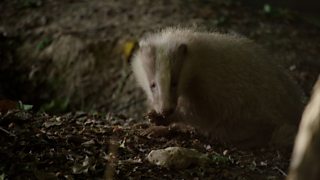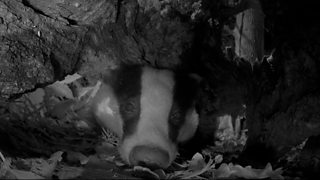By Eve Edwards from the Autumnwatch digital team

Erythristic badger
As the nights draw in and the weather gets colder, it can be hard to find a silver lining to the shorter days that Autumn brings. If, however, like me, you have been watching Autumnwatch’s New Forest live cameras, you will know that once darkness falls the forest floor comes alive. One by one, striped faces and bulky grey bodies begin to appear - our favourite badger family is emerging above ground for a busy night of foraging and socialising.
Most badgers are large and grey, with a short fluffy tail, a black belly and paws, and a distinctive black and white striped face. As you may have noticed however, there are a few paler individuals in this family group; we think that these are erythristic badgers, in which the black pigment is replaced by a reddish colour – we got some great views of them in the daylight during Springwatch this year. Badgers can also be albino, where none of the dark pigment melanin is produced at all, or leucistic, which is caused by a partial lack of melanin. It is exciting to see such colour variations within this group as it enables us to recognise certain individuals, and we can therefore get to know their characters.
Despite their unmistakable appearance, and the fact that they are the UK’s largest land carnivore, very few people have actually seen a badger in the flesh. I myself, despite having grown up in the countryside surrounded by woodland, had only ever caught glimpses of them lumbering away from headlights, or more often and much more sadly, casualties on the side of the road. What a treat it is then, for so many of us to have this exciting insight into the secret lives of an entire badger family this Autumn, whose playful antics are sure to bring a pocket of joy on an autumn evening.

Group of badgers by their sett
Where do they live?
Badgers are very sociable creatures, living in family groups known as ‘clans’, which typically consist of around 4 - 7 individuals. A clan of badgers will live together within a network of underground tunnels and chambers known as a ‘sett’. These setts can be highly elaborate in structure and will be used and maintained by generations of the same badger clan – some setts can be over 100 years old! The sett network consists of a main sett as well as several smaller outlying setts. The family group will spend most of their time and raise their young within the main sett. The outlying setts then provide safe places for badgers to retreat to if needed whilst out foraging.
House-proud, and very clean, badgers take good care of these underground homes. They will keep their sleeping areas clean by dragging out old bedding material such as hay, bracken and grass, carrying it under their chin to remove it from the sett. This behaviour helps to prevent a build-up of parasites. Badgers will also deposit their faeces in communal shallow pits called ‘latrines’ which are situated outside of the sett, above ground.
Badger latrines also function as territory markers, as they will often be found on the borders between territories of different clans; these areas can be highly varied in size. The same routes will often be used by badgers as they navigate around their territories above ground, leading to a network of well-trodden paths through the undergrowth around their setts.

A badger foraging
What do they do?
As nocturnal animals, badgers spend much of their day sleeping underground in their setts, only emerging at dusk to feed. Badgers are omnivorous and have a highly varied diet – they feed on worms, slugs, invertebrates, fruit, berries, nuts, plants and birds’ eggs. Around 80% of a badger’s diet is made up of earthworms – they can eat several hundred in one night! Although they do not hibernate, it is important for badgers to lay down fat reserves for the winter, so during autumn they will feed heavily on nuts, seeds and berries. Their exceptional sense of smell, strong paws and long, sharp claws make them expert foragers who are well adapted for digging in the soil.
A badger’s night-time activity is also an opportunity for them to engage in important social interactions within the group, strengthening their social bonds. Badgers engage in frequent social grooming known as ‘allogrooming’ where they will groom each other to remove parasites such as fleas and lice. This is a reciprocal process, where badgers who groom another individual will get groomed in return - quite literally, “you scratch my back, I’ll scratch yours”! They also exhibit a behaviour known as ‘bum-pressing’ - here an individual will press the scent gland under its tail onto another badger, meaning that members of the group will all share a common odour which further strengthens their bond. There’s fun to be had too as a badger, with juveniles often playing around the sett, appearing to particularly favour leapfrog and king-of-the-castle.
Although mating happens year-round (but predominantly between February and May), a process called ‘delayed implantation’ occurs after mating which enables the birth of cubs when conditions are more favourable. Cubs are therefore born in January or February and will begin appearing above ground 8 - 10 weeks later. The slightly smaller individuals you may see in this family group will be this year’s cubs. Cubs typically reach maturity at just over a year old, and once mature, they will either remain in the family group or disperse to establish new territories elsewhere.

Badger having a scratch
